Dissertation Partial: Drama Therapy for Adolescents with Anxiety
VerifiedAdded on 2023/01/03
|46
|13575
|25
Report
AI Summary
This dissertation partial presents a systematic review of the effectiveness of drama therapy in treating anxiety issues in adolescents. It addresses the consequences of untreated anxiety, the rising popularity of non-traditional therapies, and the efficacy of drama therapy in reducing anxiety. The research employs a literature review, examining Landy's role theory and exploring various anxiety disorders prevalent in adolescents, such as social anxiety, generalized anxiety, and specific phobias. The study aims to provide insights for practitioners and educators, highlighting the benefits of drama therapy as an alternative to traditional methods. The paper also explores the rationale behind the research, including the prevalence of anxiety in adolescents, the limitations of conventional treatments, and the potential of drama therapy as a medium of intervention. The methodology involves a systematic review of existing literature, using keywords such as 'anxiety', 'adolescent anxiety', and 'drama therapy' across databases like CINAHL, Medline, and PubMed. The findings aim to encourage the incorporation of drama therapy in practice and benefit professionals working with adolescents.
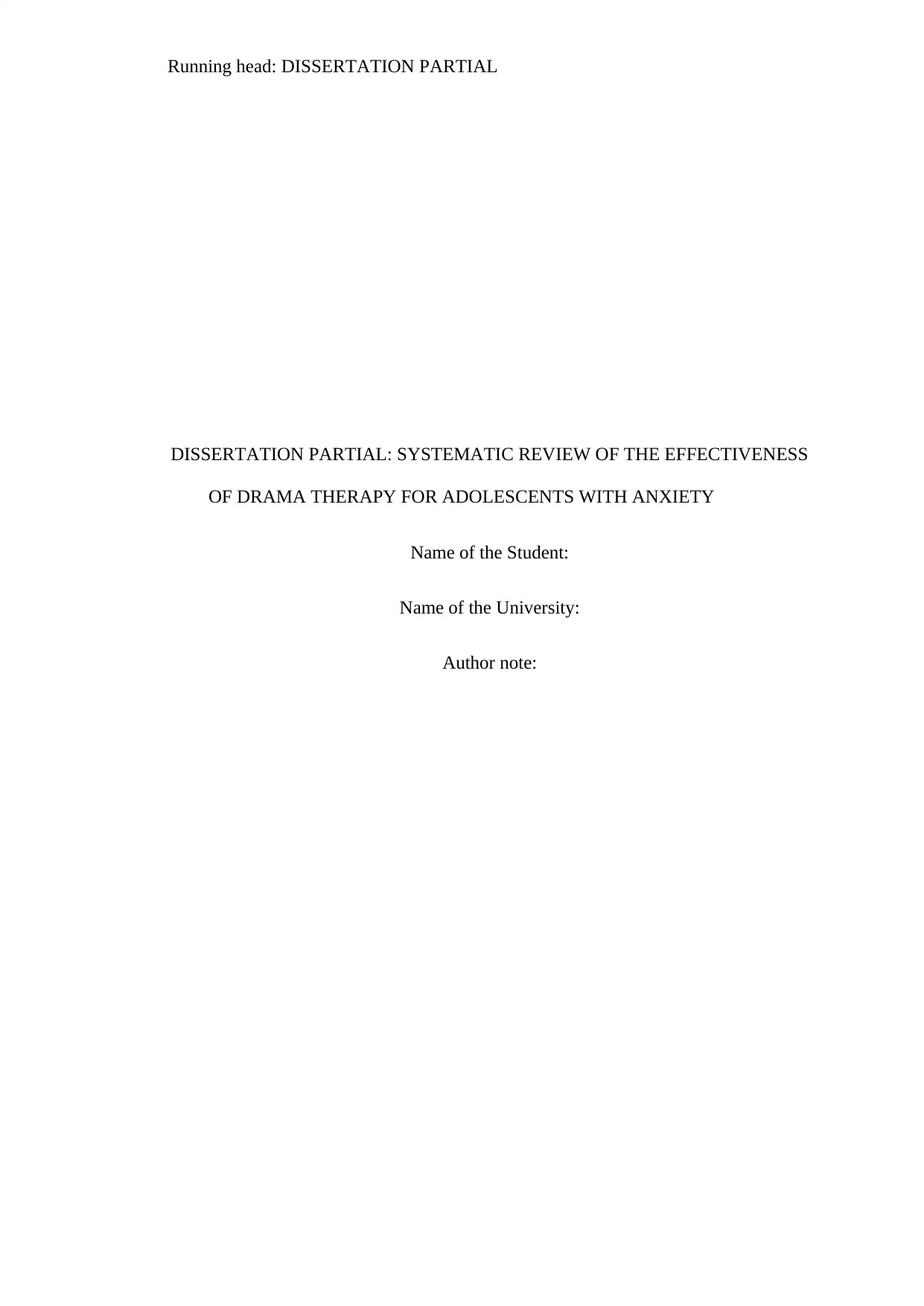
Running head: DISSERTATION PARTIAL
DISSERTATION PARTIAL: SYSTEMATIC REVIEW OF THE EFFECTIVENESS
OF DRAMA THERAPY FOR ADOLESCENTS WITH ANXIETY
Name of the Student:
Name of the University:
Author note:
DISSERTATION PARTIAL: SYSTEMATIC REVIEW OF THE EFFECTIVENESS
OF DRAMA THERAPY FOR ADOLESCENTS WITH ANXIETY
Name of the Student:
Name of the University:
Author note:
Paraphrase This Document
Need a fresh take? Get an instant paraphrase of this document with our AI Paraphraser

20DISSERTATION PARTIAL: EFFECTIVENESS OF DRAMA THERAPY
Abstract
Treatments administered conventionally and traditionally for management of anxiety
in adolescents, such pharmacology and psychotherapy, are met with rebellion and distress.
Such resistance results in aggravation of symptoms and impairment of adolescents’ social-
emotional development. For this reason, alternative approaches have been postulated in the
management of anxiety in adolescents. These approaches are considered popular and
effective as they are sensitive and appreciate liberal expression of an adolescent's complex
emotional, psychological and cognitive needs. This research paper evaluated the effectiveness
of drama therapy for treating anxiety issues in adolescents. The research paper answered
three questions: (a) What are the consequences in the individual, if adolescents with anxiety
issues are left untreated? (b) Why are non-traditional forms of therapy gaining popularity in
treating anxiety issues? And (c) How effective is drama therapy in reducing anxiety issues in
adolescents? This paper also examined Landy’s role theory and additional theoretical
observations. This research adopted a systematic review of existing literature and focused on
the collection of qualitative data to create an awareness of the effectiveness of drama therapy
in treating adolescents with anxiety issues.
Keywords: anxiety treatments, adolescents, drama therapy
Abstract
Treatments administered conventionally and traditionally for management of anxiety
in adolescents, such pharmacology and psychotherapy, are met with rebellion and distress.
Such resistance results in aggravation of symptoms and impairment of adolescents’ social-
emotional development. For this reason, alternative approaches have been postulated in the
management of anxiety in adolescents. These approaches are considered popular and
effective as they are sensitive and appreciate liberal expression of an adolescent's complex
emotional, psychological and cognitive needs. This research paper evaluated the effectiveness
of drama therapy for treating anxiety issues in adolescents. The research paper answered
three questions: (a) What are the consequences in the individual, if adolescents with anxiety
issues are left untreated? (b) Why are non-traditional forms of therapy gaining popularity in
treating anxiety issues? And (c) How effective is drama therapy in reducing anxiety issues in
adolescents? This paper also examined Landy’s role theory and additional theoretical
observations. This research adopted a systematic review of existing literature and focused on
the collection of qualitative data to create an awareness of the effectiveness of drama therapy
in treating adolescents with anxiety issues.
Keywords: anxiety treatments, adolescents, drama therapy
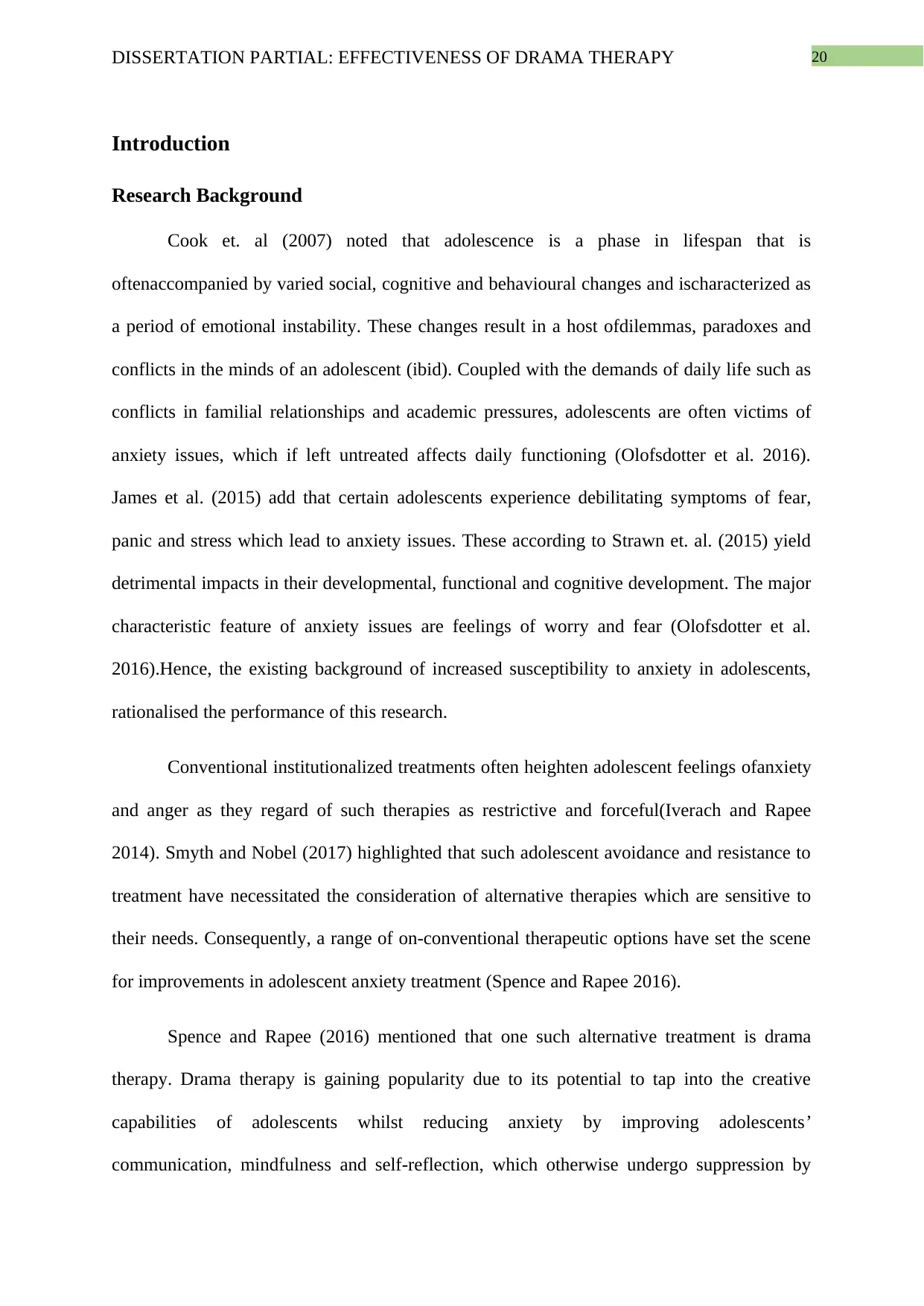
20DISSERTATION PARTIAL: EFFECTIVENESS OF DRAMA THERAPY
Introduction
Research Background
Cook et. al (2007) noted that adolescence is a phase in lifespan that is
oftenaccompanied by varied social, cognitive and behavioural changes and ischaracterized as
a period of emotional instability. These changes result in a host ofdilemmas, paradoxes and
conflicts in the minds of an adolescent (ibid). Coupled with the demands of daily life such as
conflicts in familial relationships and academic pressures, adolescents are often victims of
anxiety issues, which if left untreated affects daily functioning (Olofsdotter et al. 2016).
James et al. (2015) add that certain adolescents experience debilitating symptoms of fear,
panic and stress which lead to anxiety issues. These according to Strawn et. al. (2015) yield
detrimental impacts in their developmental, functional and cognitive development. The major
characteristic feature of anxiety issues are feelings of worry and fear (Olofsdotter et al.
2016).Hence, the existing background of increased susceptibility to anxiety in adolescents,
rationalised the performance of this research.
Conventional institutionalized treatments often heighten adolescent feelings ofanxiety
and anger as they regard of such therapies as restrictive and forceful(Iverach and Rapee
2014). Smyth and Nobel (2017) highlighted that such adolescent avoidance and resistance to
treatment have necessitated the consideration of alternative therapies which are sensitive to
their needs. Consequently, a range of on-conventional therapeutic options have set the scene
for improvements in adolescent anxiety treatment (Spence and Rapee 2016).
Spence and Rapee (2016) mentioned that one such alternative treatment is drama
therapy. Drama therapy is gaining popularity due to its potential to tap into the creative
capabilities of adolescents whilst reducing anxiety by improving adolescents’
communication, mindfulness and self-reflection, which otherwise undergo suppression by
Introduction
Research Background
Cook et. al (2007) noted that adolescence is a phase in lifespan that is
oftenaccompanied by varied social, cognitive and behavioural changes and ischaracterized as
a period of emotional instability. These changes result in a host ofdilemmas, paradoxes and
conflicts in the minds of an adolescent (ibid). Coupled with the demands of daily life such as
conflicts in familial relationships and academic pressures, adolescents are often victims of
anxiety issues, which if left untreated affects daily functioning (Olofsdotter et al. 2016).
James et al. (2015) add that certain adolescents experience debilitating symptoms of fear,
panic and stress which lead to anxiety issues. These according to Strawn et. al. (2015) yield
detrimental impacts in their developmental, functional and cognitive development. The major
characteristic feature of anxiety issues are feelings of worry and fear (Olofsdotter et al.
2016).Hence, the existing background of increased susceptibility to anxiety in adolescents,
rationalised the performance of this research.
Conventional institutionalized treatments often heighten adolescent feelings ofanxiety
and anger as they regard of such therapies as restrictive and forceful(Iverach and Rapee
2014). Smyth and Nobel (2017) highlighted that such adolescent avoidance and resistance to
treatment have necessitated the consideration of alternative therapies which are sensitive to
their needs. Consequently, a range of on-conventional therapeutic options have set the scene
for improvements in adolescent anxiety treatment (Spence and Rapee 2016).
Spence and Rapee (2016) mentioned that one such alternative treatment is drama
therapy. Drama therapy is gaining popularity due to its potential to tap into the creative
capabilities of adolescents whilst reducing anxiety by improving adolescents’
communication, mindfulness and self-reflection, which otherwise undergo suppression by
⊘ This is a preview!⊘
Do you want full access?
Subscribe today to unlock all pages.

Trusted by 1+ million students worldwide
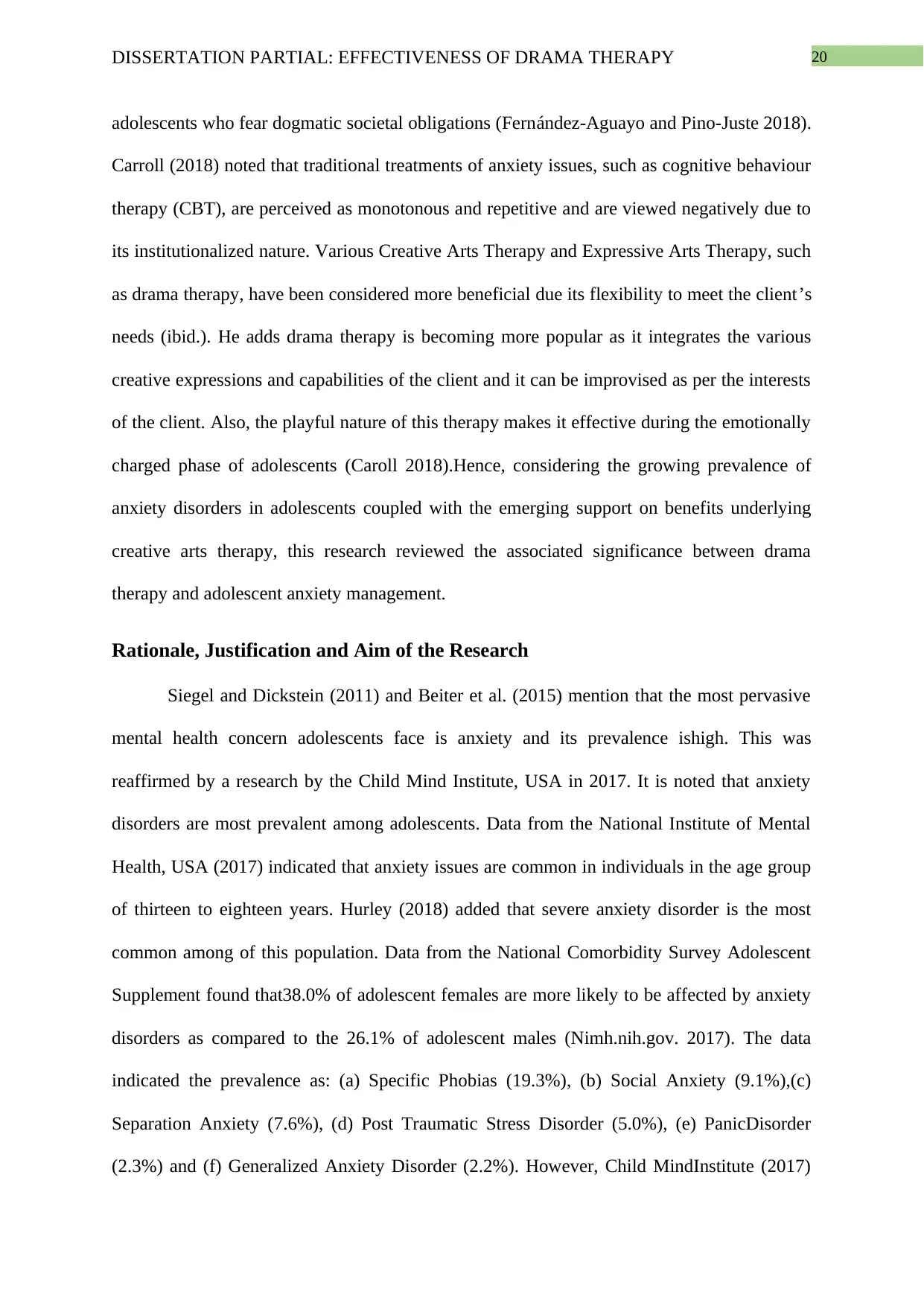
20DISSERTATION PARTIAL: EFFECTIVENESS OF DRAMA THERAPY
adolescents who fear dogmatic societal obligations (Fernández-Aguayo and Pino-Juste 2018).
Carroll (2018) noted that traditional treatments of anxiety issues, such as cognitive behaviour
therapy (CBT), are perceived as monotonous and repetitive and are viewed negatively due to
its institutionalized nature. Various Creative Arts Therapy and Expressive Arts Therapy, such
as drama therapy, have been considered more beneficial due its flexibility to meet the client’s
needs (ibid.). He adds drama therapy is becoming more popular as it integrates the various
creative expressions and capabilities of the client and it can be improvised as per the interests
of the client. Also, the playful nature of this therapy makes it effective during the emotionally
charged phase of adolescents (Caroll 2018).Hence, considering the growing prevalence of
anxiety disorders in adolescents coupled with the emerging support on benefits underlying
creative arts therapy, this research reviewed the associated significance between drama
therapy and adolescent anxiety management.
Rationale, Justification and Aim of the Research
Siegel and Dickstein (2011) and Beiter et al. (2015) mention that the most pervasive
mental health concern adolescents face is anxiety and its prevalence ishigh. This was
reaffirmed by a research by the Child Mind Institute, USA in 2017. It is noted that anxiety
disorders are most prevalent among adolescents. Data from the National Institute of Mental
Health, USA (2017) indicated that anxiety issues are common in individuals in the age group
of thirteen to eighteen years. Hurley (2018) added that severe anxiety disorder is the most
common among of this population. Data from the National Comorbidity Survey Adolescent
Supplement found that38.0% of adolescent females are more likely to be affected by anxiety
disorders as compared to the 26.1% of adolescent males (Nimh.nih.gov. 2017). The data
indicated the prevalence as: (a) Specific Phobias (19.3%), (b) Social Anxiety (9.1%),(c)
Separation Anxiety (7.6%), (d) Post Traumatic Stress Disorder (5.0%), (e) PanicDisorder
(2.3%) and (f) Generalized Anxiety Disorder (2.2%). However, Child MindInstitute (2017)
adolescents who fear dogmatic societal obligations (Fernández-Aguayo and Pino-Juste 2018).
Carroll (2018) noted that traditional treatments of anxiety issues, such as cognitive behaviour
therapy (CBT), are perceived as monotonous and repetitive and are viewed negatively due to
its institutionalized nature. Various Creative Arts Therapy and Expressive Arts Therapy, such
as drama therapy, have been considered more beneficial due its flexibility to meet the client’s
needs (ibid.). He adds drama therapy is becoming more popular as it integrates the various
creative expressions and capabilities of the client and it can be improvised as per the interests
of the client. Also, the playful nature of this therapy makes it effective during the emotionally
charged phase of adolescents (Caroll 2018).Hence, considering the growing prevalence of
anxiety disorders in adolescents coupled with the emerging support on benefits underlying
creative arts therapy, this research reviewed the associated significance between drama
therapy and adolescent anxiety management.
Rationale, Justification and Aim of the Research
Siegel and Dickstein (2011) and Beiter et al. (2015) mention that the most pervasive
mental health concern adolescents face is anxiety and its prevalence ishigh. This was
reaffirmed by a research by the Child Mind Institute, USA in 2017. It is noted that anxiety
disorders are most prevalent among adolescents. Data from the National Institute of Mental
Health, USA (2017) indicated that anxiety issues are common in individuals in the age group
of thirteen to eighteen years. Hurley (2018) added that severe anxiety disorder is the most
common among of this population. Data from the National Comorbidity Survey Adolescent
Supplement found that38.0% of adolescent females are more likely to be affected by anxiety
disorders as compared to the 26.1% of adolescent males (Nimh.nih.gov. 2017). The data
indicated the prevalence as: (a) Specific Phobias (19.3%), (b) Social Anxiety (9.1%),(c)
Separation Anxiety (7.6%), (d) Post Traumatic Stress Disorder (5.0%), (e) PanicDisorder
(2.3%) and (f) Generalized Anxiety Disorder (2.2%). However, Child MindInstitute (2017)
Paraphrase This Document
Need a fresh take? Get an instant paraphrase of this document with our AI Paraphraser
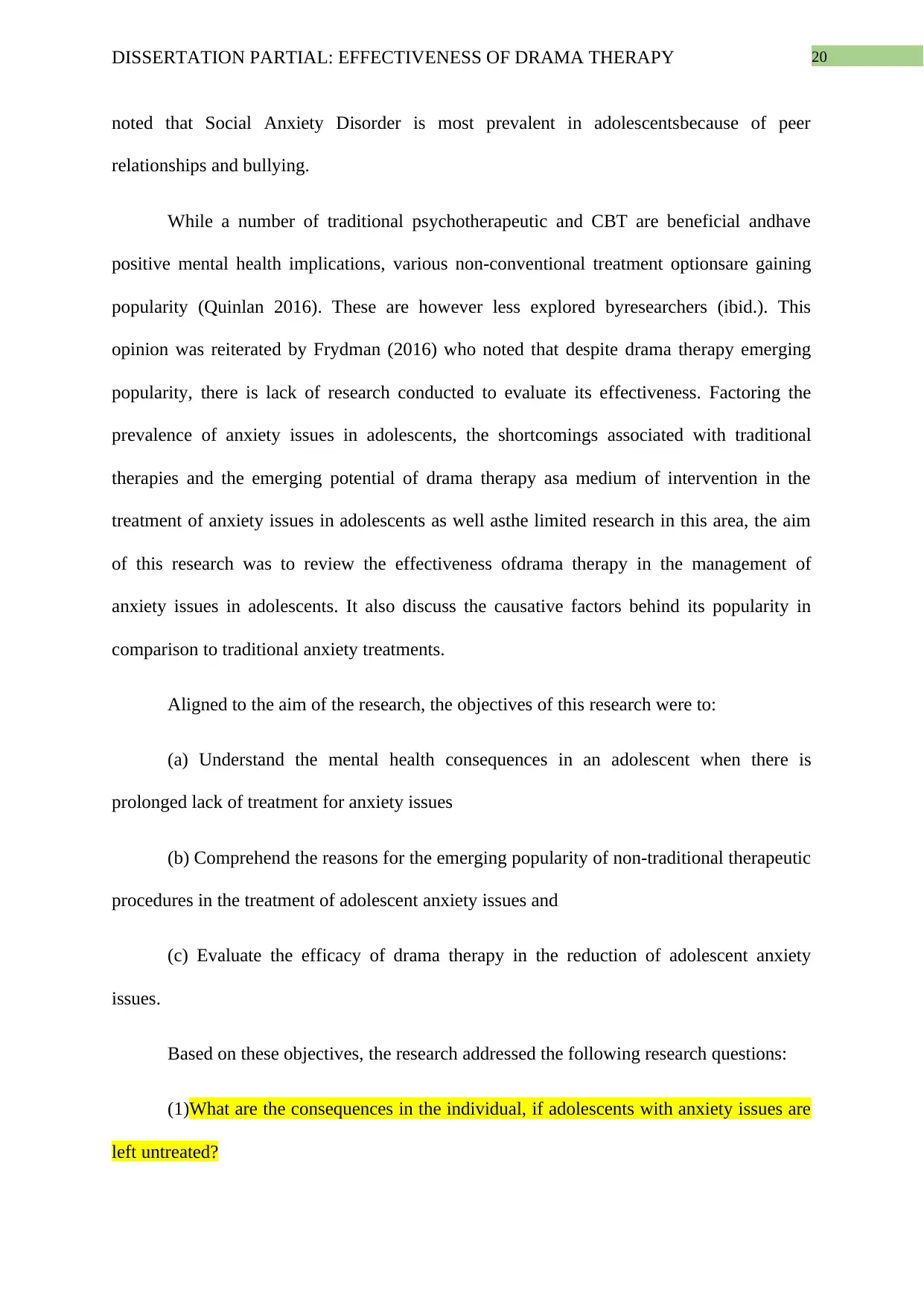
20DISSERTATION PARTIAL: EFFECTIVENESS OF DRAMA THERAPY
noted that Social Anxiety Disorder is most prevalent in adolescentsbecause of peer
relationships and bullying.
While a number of traditional psychotherapeutic and CBT are beneficial andhave
positive mental health implications, various non-conventional treatment optionsare gaining
popularity (Quinlan 2016). These are however less explored byresearchers (ibid.). This
opinion was reiterated by Frydman (2016) who noted that despite drama therapy emerging
popularity, there is lack of research conducted to evaluate its effectiveness. Factoring the
prevalence of anxiety issues in adolescents, the shortcomings associated with traditional
therapies and the emerging potential of drama therapy asa medium of intervention in the
treatment of anxiety issues in adolescents as well asthe limited research in this area, the aim
of this research was to review the effectiveness ofdrama therapy in the management of
anxiety issues in adolescents. It also discuss the causative factors behind its popularity in
comparison to traditional anxiety treatments.
Aligned to the aim of the research, the objectives of this research were to:
(a) Understand the mental health consequences in an adolescent when there is
prolonged lack of treatment for anxiety issues
(b) Comprehend the reasons for the emerging popularity of non-traditional therapeutic
procedures in the treatment of adolescent anxiety issues and
(c) Evaluate the efficacy of drama therapy in the reduction of adolescent anxiety
issues.
Based on these objectives, the research addressed the following research questions:
(1)What are the consequences in the individual, if adolescents with anxiety issues are
left untreated?
noted that Social Anxiety Disorder is most prevalent in adolescentsbecause of peer
relationships and bullying.
While a number of traditional psychotherapeutic and CBT are beneficial andhave
positive mental health implications, various non-conventional treatment optionsare gaining
popularity (Quinlan 2016). These are however less explored byresearchers (ibid.). This
opinion was reiterated by Frydman (2016) who noted that despite drama therapy emerging
popularity, there is lack of research conducted to evaluate its effectiveness. Factoring the
prevalence of anxiety issues in adolescents, the shortcomings associated with traditional
therapies and the emerging potential of drama therapy asa medium of intervention in the
treatment of anxiety issues in adolescents as well asthe limited research in this area, the aim
of this research was to review the effectiveness ofdrama therapy in the management of
anxiety issues in adolescents. It also discuss the causative factors behind its popularity in
comparison to traditional anxiety treatments.
Aligned to the aim of the research, the objectives of this research were to:
(a) Understand the mental health consequences in an adolescent when there is
prolonged lack of treatment for anxiety issues
(b) Comprehend the reasons for the emerging popularity of non-traditional therapeutic
procedures in the treatment of adolescent anxiety issues and
(c) Evaluate the efficacy of drama therapy in the reduction of adolescent anxiety
issues.
Based on these objectives, the research addressed the following research questions:
(1)What are the consequences in the individual, if adolescents with anxiety issues are
left untreated?
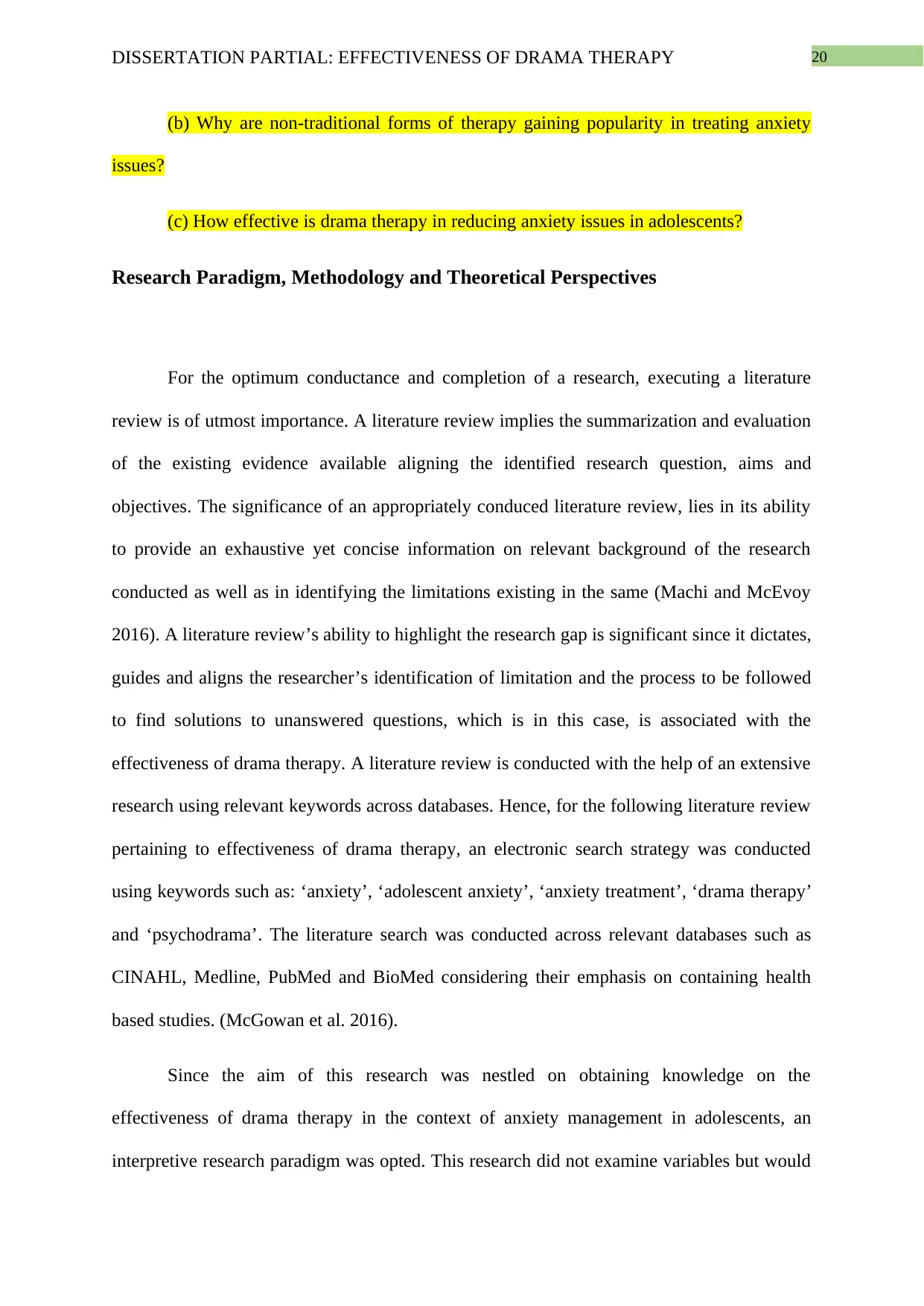
20DISSERTATION PARTIAL: EFFECTIVENESS OF DRAMA THERAPY
(b) Why are non-traditional forms of therapy gaining popularity in treating anxiety
issues?
(c) How effective is drama therapy in reducing anxiety issues in adolescents?
Research Paradigm, Methodology and Theoretical Perspectives
For the optimum conductance and completion of a research, executing a literature
review is of utmost importance. A literature review implies the summarization and evaluation
of the existing evidence available aligning the identified research question, aims and
objectives. The significance of an appropriately conduced literature review, lies in its ability
to provide an exhaustive yet concise information on relevant background of the research
conducted as well as in identifying the limitations existing in the same (Machi and McEvoy
2016). A literature review’s ability to highlight the research gap is significant since it dictates,
guides and aligns the researcher’s identification of limitation and the process to be followed
to find solutions to unanswered questions, which is in this case, is associated with the
effectiveness of drama therapy. A literature review is conducted with the help of an extensive
research using relevant keywords across databases. Hence, for the following literature review
pertaining to effectiveness of drama therapy, an electronic search strategy was conducted
using keywords such as: ‘anxiety’, ‘adolescent anxiety’, ‘anxiety treatment’, ‘drama therapy’
and ‘psychodrama’. The literature search was conducted across relevant databases such as
CINAHL, Medline, PubMed and BioMed considering their emphasis on containing health
based studies. (McGowan et al. 2016).
Since the aim of this research was nestled on obtaining knowledge on the
effectiveness of drama therapy in the context of anxiety management in adolescents, an
interpretive research paradigm was opted. This research did not examine variables but would
(b) Why are non-traditional forms of therapy gaining popularity in treating anxiety
issues?
(c) How effective is drama therapy in reducing anxiety issues in adolescents?
Research Paradigm, Methodology and Theoretical Perspectives
For the optimum conductance and completion of a research, executing a literature
review is of utmost importance. A literature review implies the summarization and evaluation
of the existing evidence available aligning the identified research question, aims and
objectives. The significance of an appropriately conduced literature review, lies in its ability
to provide an exhaustive yet concise information on relevant background of the research
conducted as well as in identifying the limitations existing in the same (Machi and McEvoy
2016). A literature review’s ability to highlight the research gap is significant since it dictates,
guides and aligns the researcher’s identification of limitation and the process to be followed
to find solutions to unanswered questions, which is in this case, is associated with the
effectiveness of drama therapy. A literature review is conducted with the help of an extensive
research using relevant keywords across databases. Hence, for the following literature review
pertaining to effectiveness of drama therapy, an electronic search strategy was conducted
using keywords such as: ‘anxiety’, ‘adolescent anxiety’, ‘anxiety treatment’, ‘drama therapy’
and ‘psychodrama’. The literature search was conducted across relevant databases such as
CINAHL, Medline, PubMed and BioMed considering their emphasis on containing health
based studies. (McGowan et al. 2016).
Since the aim of this research was nestled on obtaining knowledge on the
effectiveness of drama therapy in the context of anxiety management in adolescents, an
interpretive research paradigm was opted. This research did not examine variables but would
⊘ This is a preview!⊘
Do you want full access?
Subscribe today to unlock all pages.

Trusted by 1+ million students worldwide
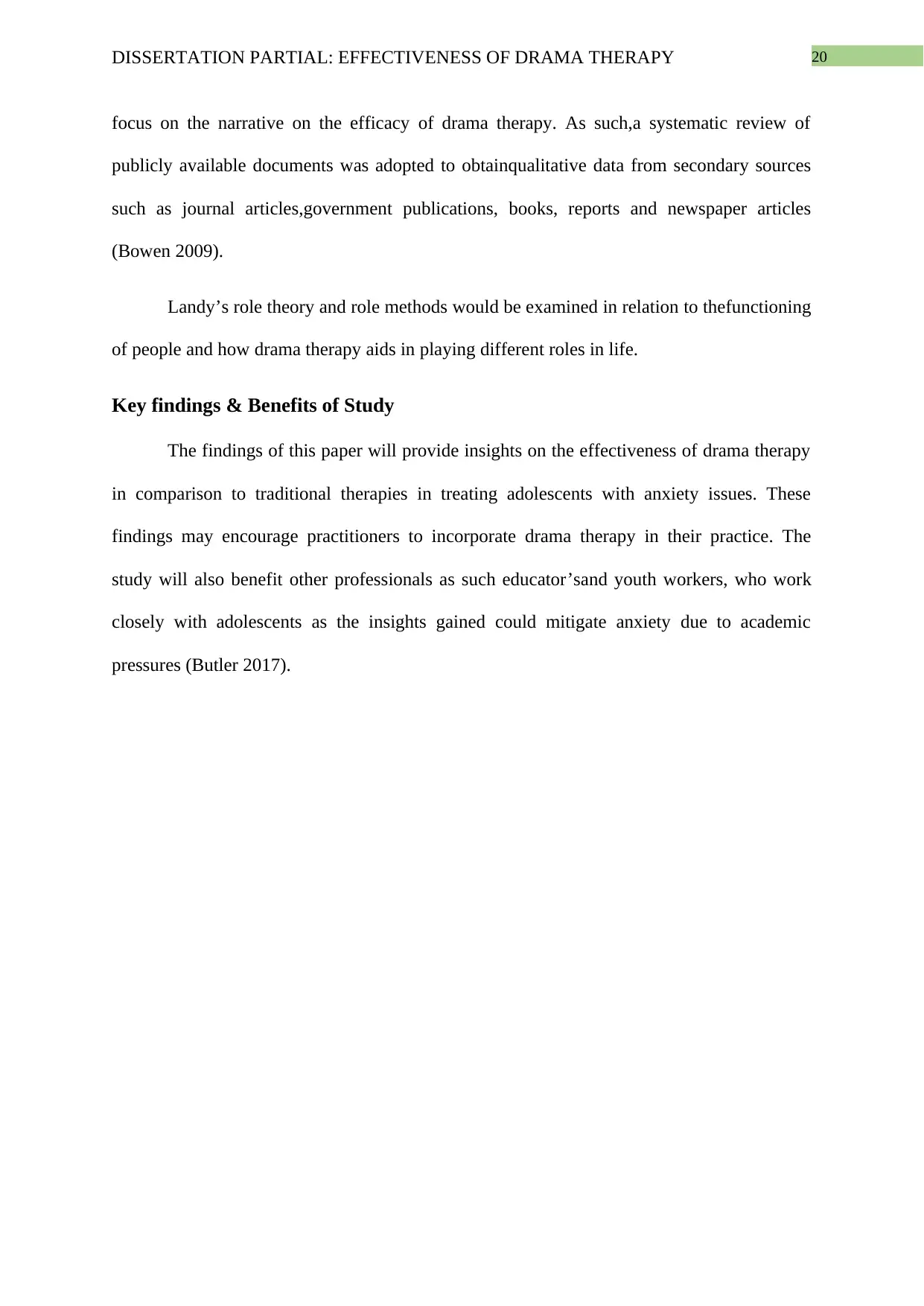
20DISSERTATION PARTIAL: EFFECTIVENESS OF DRAMA THERAPY
focus on the narrative on the efficacy of drama therapy. As such,a systematic review of
publicly available documents was adopted to obtainqualitative data from secondary sources
such as journal articles,government publications, books, reports and newspaper articles
(Bowen 2009).
Landy’s role theory and role methods would be examined in relation to thefunctioning
of people and how drama therapy aids in playing different roles in life.
Key findings & Benefits of Study
The findings of this paper will provide insights on the effectiveness of drama therapy
in comparison to traditional therapies in treating adolescents with anxiety issues. These
findings may encourage practitioners to incorporate drama therapy in their practice. The
study will also benefit other professionals as such educator’sand youth workers, who work
closely with adolescents as the insights gained could mitigate anxiety due to academic
pressures (Butler 2017).
focus on the narrative on the efficacy of drama therapy. As such,a systematic review of
publicly available documents was adopted to obtainqualitative data from secondary sources
such as journal articles,government publications, books, reports and newspaper articles
(Bowen 2009).
Landy’s role theory and role methods would be examined in relation to thefunctioning
of people and how drama therapy aids in playing different roles in life.
Key findings & Benefits of Study
The findings of this paper will provide insights on the effectiveness of drama therapy
in comparison to traditional therapies in treating adolescents with anxiety issues. These
findings may encourage practitioners to incorporate drama therapy in their practice. The
study will also benefit other professionals as such educator’sand youth workers, who work
closely with adolescents as the insights gained could mitigate anxiety due to academic
pressures (Butler 2017).
Paraphrase This Document
Need a fresh take? Get an instant paraphrase of this document with our AI Paraphraser
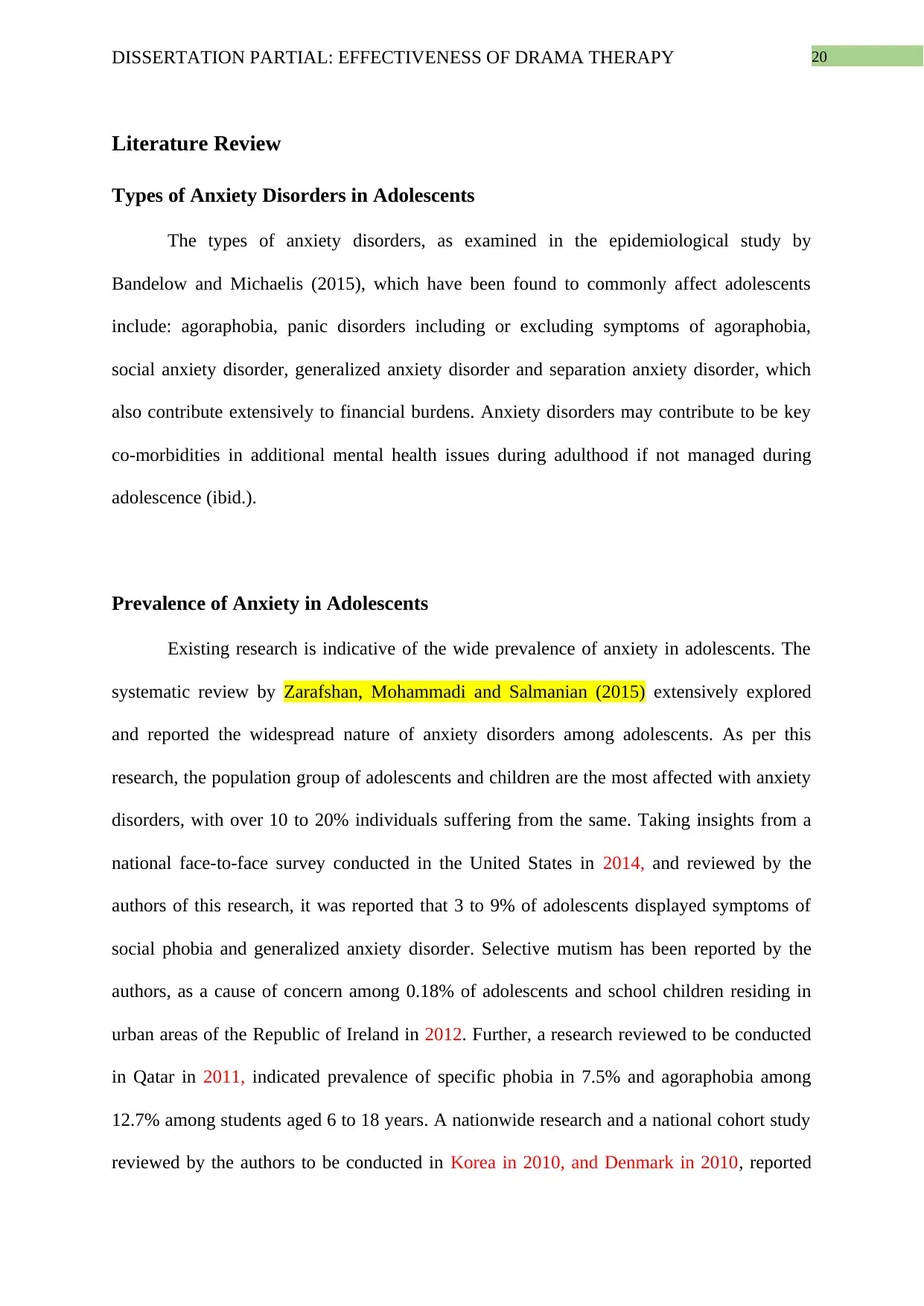
20DISSERTATION PARTIAL: EFFECTIVENESS OF DRAMA THERAPY
Literature Review
Types of Anxiety Disorders in Adolescents
The types of anxiety disorders, as examined in the epidemiological study by
Bandelow and Michaelis (2015), which have been found to commonly affect adolescents
include: agoraphobia, panic disorders including or excluding symptoms of agoraphobia,
social anxiety disorder, generalized anxiety disorder and separation anxiety disorder, which
also contribute extensively to financial burdens. Anxiety disorders may contribute to be key
co-morbidities in additional mental health issues during adulthood if not managed during
adolescence (ibid.).
Prevalence of Anxiety in Adolescents
Existing research is indicative of the wide prevalence of anxiety in adolescents. The
systematic review by Zarafshan, Mohammadi and Salmanian (2015) extensively explored
and reported the widespread nature of anxiety disorders among adolescents. As per this
research, the population group of adolescents and children are the most affected with anxiety
disorders, with over 10 to 20% individuals suffering from the same. Taking insights from a
national face-to-face survey conducted in the United States in 2014, and reviewed by the
authors of this research, it was reported that 3 to 9% of adolescents displayed symptoms of
social phobia and generalized anxiety disorder. Selective mutism has been reported by the
authors, as a cause of concern among 0.18% of adolescents and school children residing in
urban areas of the Republic of Ireland in 2012. Further, a research reviewed to be conducted
in Qatar in 2011, indicated prevalence of specific phobia in 7.5% and agoraphobia among
12.7% among students aged 6 to 18 years. A nationwide research and a national cohort study
reviewed by the authors to be conducted in Korea in 2010, and Denmark in 2010, reported
Literature Review
Types of Anxiety Disorders in Adolescents
The types of anxiety disorders, as examined in the epidemiological study by
Bandelow and Michaelis (2015), which have been found to commonly affect adolescents
include: agoraphobia, panic disorders including or excluding symptoms of agoraphobia,
social anxiety disorder, generalized anxiety disorder and separation anxiety disorder, which
also contribute extensively to financial burdens. Anxiety disorders may contribute to be key
co-morbidities in additional mental health issues during adulthood if not managed during
adolescence (ibid.).
Prevalence of Anxiety in Adolescents
Existing research is indicative of the wide prevalence of anxiety in adolescents. The
systematic review by Zarafshan, Mohammadi and Salmanian (2015) extensively explored
and reported the widespread nature of anxiety disorders among adolescents. As per this
research, the population group of adolescents and children are the most affected with anxiety
disorders, with over 10 to 20% individuals suffering from the same. Taking insights from a
national face-to-face survey conducted in the United States in 2014, and reviewed by the
authors of this research, it was reported that 3 to 9% of adolescents displayed symptoms of
social phobia and generalized anxiety disorder. Selective mutism has been reported by the
authors, as a cause of concern among 0.18% of adolescents and school children residing in
urban areas of the Republic of Ireland in 2012. Further, a research reviewed to be conducted
in Qatar in 2011, indicated prevalence of specific phobia in 7.5% and agoraphobia among
12.7% among students aged 6 to 18 years. A nationwide research and a national cohort study
reviewed by the authors to be conducted in Korea in 2010, and Denmark in 2010, reported
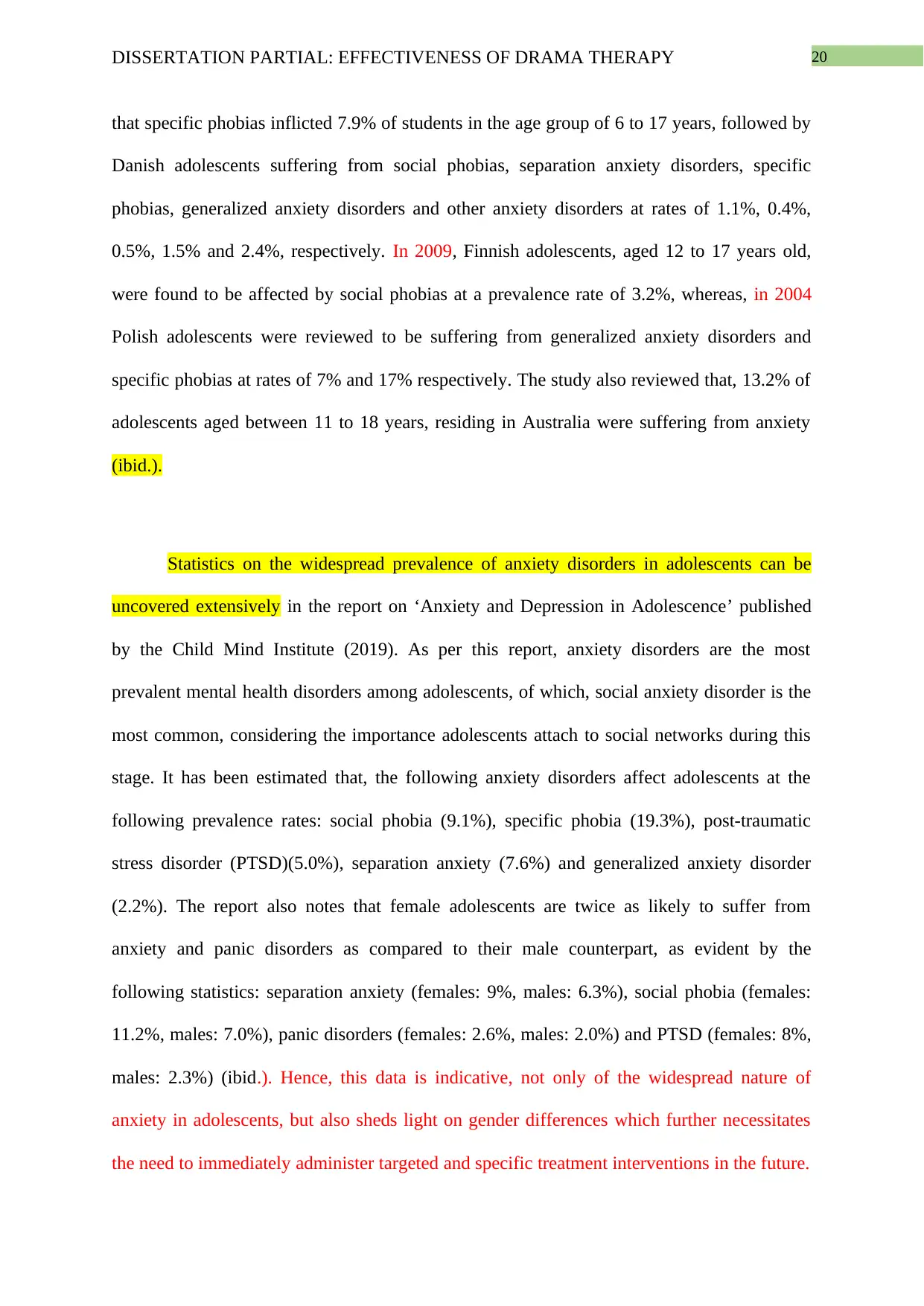
20DISSERTATION PARTIAL: EFFECTIVENESS OF DRAMA THERAPY
that specific phobias inflicted 7.9% of students in the age group of 6 to 17 years, followed by
Danish adolescents suffering from social phobias, separation anxiety disorders, specific
phobias, generalized anxiety disorders and other anxiety disorders at rates of 1.1%, 0.4%,
0.5%, 1.5% and 2.4%, respectively. In 2009, Finnish adolescents, aged 12 to 17 years old,
were found to be affected by social phobias at a prevalence rate of 3.2%, whereas, in 2004
Polish adolescents were reviewed to be suffering from generalized anxiety disorders and
specific phobias at rates of 7% and 17% respectively. The study also reviewed that, 13.2% of
adolescents aged between 11 to 18 years, residing in Australia were suffering from anxiety
(ibid.).
Statistics on the widespread prevalence of anxiety disorders in adolescents can be
uncovered extensively in the report on ‘Anxiety and Depression in Adolescence’ published
by the Child Mind Institute (2019). As per this report, anxiety disorders are the most
prevalent mental health disorders among adolescents, of which, social anxiety disorder is the
most common, considering the importance adolescents attach to social networks during this
stage. It has been estimated that, the following anxiety disorders affect adolescents at the
following prevalence rates: social phobia (9.1%), specific phobia (19.3%), post-traumatic
stress disorder (PTSD)(5.0%), separation anxiety (7.6%) and generalized anxiety disorder
(2.2%). The report also notes that female adolescents are twice as likely to suffer from
anxiety and panic disorders as compared to their male counterpart, as evident by the
following statistics: separation anxiety (females: 9%, males: 6.3%), social phobia (females:
11.2%, males: 7.0%), panic disorders (females: 2.6%, males: 2.0%) and PTSD (females: 8%,
males: 2.3%) (ibid.). Hence, this data is indicative, not only of the widespread nature of
anxiety in adolescents, but also sheds light on gender differences which further necessitates
the need to immediately administer targeted and specific treatment interventions in the future.
that specific phobias inflicted 7.9% of students in the age group of 6 to 17 years, followed by
Danish adolescents suffering from social phobias, separation anxiety disorders, specific
phobias, generalized anxiety disorders and other anxiety disorders at rates of 1.1%, 0.4%,
0.5%, 1.5% and 2.4%, respectively. In 2009, Finnish adolescents, aged 12 to 17 years old,
were found to be affected by social phobias at a prevalence rate of 3.2%, whereas, in 2004
Polish adolescents were reviewed to be suffering from generalized anxiety disorders and
specific phobias at rates of 7% and 17% respectively. The study also reviewed that, 13.2% of
adolescents aged between 11 to 18 years, residing in Australia were suffering from anxiety
(ibid.).
Statistics on the widespread prevalence of anxiety disorders in adolescents can be
uncovered extensively in the report on ‘Anxiety and Depression in Adolescence’ published
by the Child Mind Institute (2019). As per this report, anxiety disorders are the most
prevalent mental health disorders among adolescents, of which, social anxiety disorder is the
most common, considering the importance adolescents attach to social networks during this
stage. It has been estimated that, the following anxiety disorders affect adolescents at the
following prevalence rates: social phobia (9.1%), specific phobia (19.3%), post-traumatic
stress disorder (PTSD)(5.0%), separation anxiety (7.6%) and generalized anxiety disorder
(2.2%). The report also notes that female adolescents are twice as likely to suffer from
anxiety and panic disorders as compared to their male counterpart, as evident by the
following statistics: separation anxiety (females: 9%, males: 6.3%), social phobia (females:
11.2%, males: 7.0%), panic disorders (females: 2.6%, males: 2.0%) and PTSD (females: 8%,
males: 2.3%) (ibid.). Hence, this data is indicative, not only of the widespread nature of
anxiety in adolescents, but also sheds light on gender differences which further necessitates
the need to immediately administer targeted and specific treatment interventions in the future.
⊘ This is a preview!⊘
Do you want full access?
Subscribe today to unlock all pages.

Trusted by 1+ million students worldwide
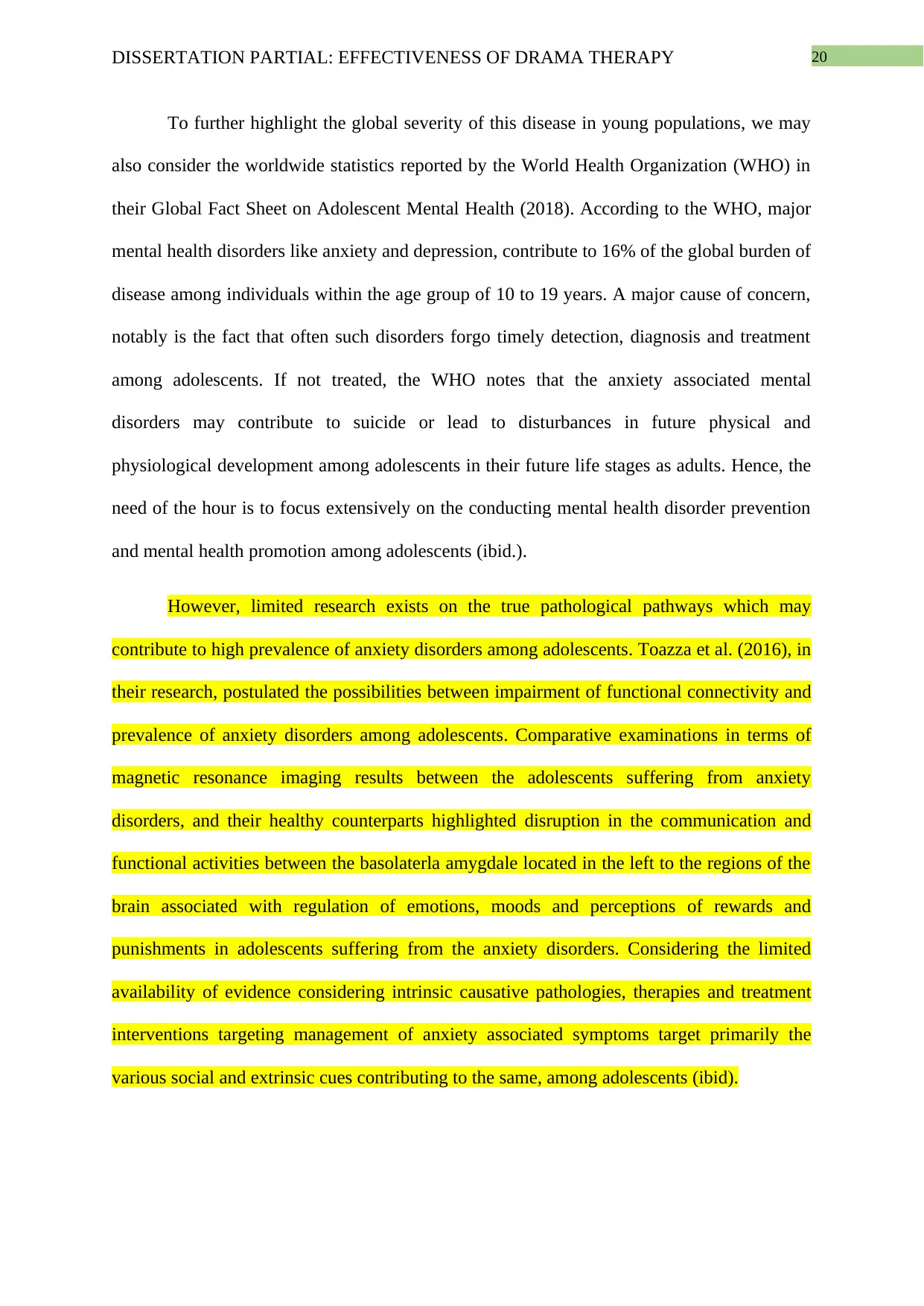
20DISSERTATION PARTIAL: EFFECTIVENESS OF DRAMA THERAPY
To further highlight the global severity of this disease in young populations, we may
also consider the worldwide statistics reported by the World Health Organization (WHO) in
their Global Fact Sheet on Adolescent Mental Health (2018). According to the WHO, major
mental health disorders like anxiety and depression, contribute to 16% of the global burden of
disease among individuals within the age group of 10 to 19 years. A major cause of concern,
notably is the fact that often such disorders forgo timely detection, diagnosis and treatment
among adolescents. If not treated, the WHO notes that the anxiety associated mental
disorders may contribute to suicide or lead to disturbances in future physical and
physiological development among adolescents in their future life stages as adults. Hence, the
need of the hour is to focus extensively on the conducting mental health disorder prevention
and mental health promotion among adolescents (ibid.).
However, limited research exists on the true pathological pathways which may
contribute to high prevalence of anxiety disorders among adolescents. Toazza et al. (2016), in
their research, postulated the possibilities between impairment of functional connectivity and
prevalence of anxiety disorders among adolescents. Comparative examinations in terms of
magnetic resonance imaging results between the adolescents suffering from anxiety
disorders, and their healthy counterparts highlighted disruption in the communication and
functional activities between the basolaterla amygdale located in the left to the regions of the
brain associated with regulation of emotions, moods and perceptions of rewards and
punishments in adolescents suffering from the anxiety disorders. Considering the limited
availability of evidence considering intrinsic causative pathologies, therapies and treatment
interventions targeting management of anxiety associated symptoms target primarily the
various social and extrinsic cues contributing to the same, among adolescents (ibid).
To further highlight the global severity of this disease in young populations, we may
also consider the worldwide statistics reported by the World Health Organization (WHO) in
their Global Fact Sheet on Adolescent Mental Health (2018). According to the WHO, major
mental health disorders like anxiety and depression, contribute to 16% of the global burden of
disease among individuals within the age group of 10 to 19 years. A major cause of concern,
notably is the fact that often such disorders forgo timely detection, diagnosis and treatment
among adolescents. If not treated, the WHO notes that the anxiety associated mental
disorders may contribute to suicide or lead to disturbances in future physical and
physiological development among adolescents in their future life stages as adults. Hence, the
need of the hour is to focus extensively on the conducting mental health disorder prevention
and mental health promotion among adolescents (ibid.).
However, limited research exists on the true pathological pathways which may
contribute to high prevalence of anxiety disorders among adolescents. Toazza et al. (2016), in
their research, postulated the possibilities between impairment of functional connectivity and
prevalence of anxiety disorders among adolescents. Comparative examinations in terms of
magnetic resonance imaging results between the adolescents suffering from anxiety
disorders, and their healthy counterparts highlighted disruption in the communication and
functional activities between the basolaterla amygdale located in the left to the regions of the
brain associated with regulation of emotions, moods and perceptions of rewards and
punishments in adolescents suffering from the anxiety disorders. Considering the limited
availability of evidence considering intrinsic causative pathologies, therapies and treatment
interventions targeting management of anxiety associated symptoms target primarily the
various social and extrinsic cues contributing to the same, among adolescents (ibid).
Paraphrase This Document
Need a fresh take? Get an instant paraphrase of this document with our AI Paraphraser

20DISSERTATION PARTIAL: EFFECTIVENESS OF DRAMA THERAPY
Further, a number of researches also indicate that the disorders and symptoms
pertaining to anxiety are reported and treated the least in adolescents (Bennet and Walkup
2018; Child Mind Institute 2017; Meyer et al. 2015; Siegel and Dickstien 2011).
Adolescents with Anxiety Issues and the Implications of Lack of Treatment
Despite the prevalence of anxiety issues in adolescents, research has noted that
anxiety disorders are the least treated problems in adolescents (Siegel and Dickstien 2011;
Meyer et al. 2015; Child Mind Institute 2017; Bennet and Walkup 2018). According to Schol
et al. (2014) prolonged lack of treatment of anxiety in adolescents results in harmful
emotional and physiological health implications which distort growth and development.
Quach et al. (2015) added that untreated anxiety results in debilitating physiological
symptoms such as; (a) difficulty in sleeping, (b) muscle soreness, (c) increased sweating and
heart rate, (d) feelings of nausea and (e) increased disease susceptibility. All of these in turn
damage the immune system (ibid.). Both research expounds that such adolescents find it
difficult to perform daily tasks because of increased forgetfulness, lack of concentration and
difficulties in proceeding or completing work successfully. These consequences aggravate
into detrimental behaviours during adulthood (Garnefski and Kraaij 2018). These behaviours
can be projected in the form of: (a) lack of relaxation due to presence of a constant state of
agitations, tension and restlessness, (b) increased uneasiness or excessive sensitivities
towards criticism, (c) excessive feelings of pessimism leading to difficulty in daily life
performance, (d) avoidance of novel challenges or unfavourable circumstances, (e) loss of
self-esteem leading to increased social isolation and withdrawal, and (f) constant
preoccupation with obsessive and compulsive thoughts and behaviors (ibid.).
Ineffectiveness of Traditional Anxiety Treatments
According to Wehry et al. (2015) and Muris and Ollendick (2015), traditional
treatment procedures in adolescents generally include a collective therapeutic approach
Further, a number of researches also indicate that the disorders and symptoms
pertaining to anxiety are reported and treated the least in adolescents (Bennet and Walkup
2018; Child Mind Institute 2017; Meyer et al. 2015; Siegel and Dickstien 2011).
Adolescents with Anxiety Issues and the Implications of Lack of Treatment
Despite the prevalence of anxiety issues in adolescents, research has noted that
anxiety disorders are the least treated problems in adolescents (Siegel and Dickstien 2011;
Meyer et al. 2015; Child Mind Institute 2017; Bennet and Walkup 2018). According to Schol
et al. (2014) prolonged lack of treatment of anxiety in adolescents results in harmful
emotional and physiological health implications which distort growth and development.
Quach et al. (2015) added that untreated anxiety results in debilitating physiological
symptoms such as; (a) difficulty in sleeping, (b) muscle soreness, (c) increased sweating and
heart rate, (d) feelings of nausea and (e) increased disease susceptibility. All of these in turn
damage the immune system (ibid.). Both research expounds that such adolescents find it
difficult to perform daily tasks because of increased forgetfulness, lack of concentration and
difficulties in proceeding or completing work successfully. These consequences aggravate
into detrimental behaviours during adulthood (Garnefski and Kraaij 2018). These behaviours
can be projected in the form of: (a) lack of relaxation due to presence of a constant state of
agitations, tension and restlessness, (b) increased uneasiness or excessive sensitivities
towards criticism, (c) excessive feelings of pessimism leading to difficulty in daily life
performance, (d) avoidance of novel challenges or unfavourable circumstances, (e) loss of
self-esteem leading to increased social isolation and withdrawal, and (f) constant
preoccupation with obsessive and compulsive thoughts and behaviors (ibid.).
Ineffectiveness of Traditional Anxiety Treatments
According to Wehry et al. (2015) and Muris and Ollendick (2015), traditional
treatment procedures in adolescents generally include a collective therapeutic approach
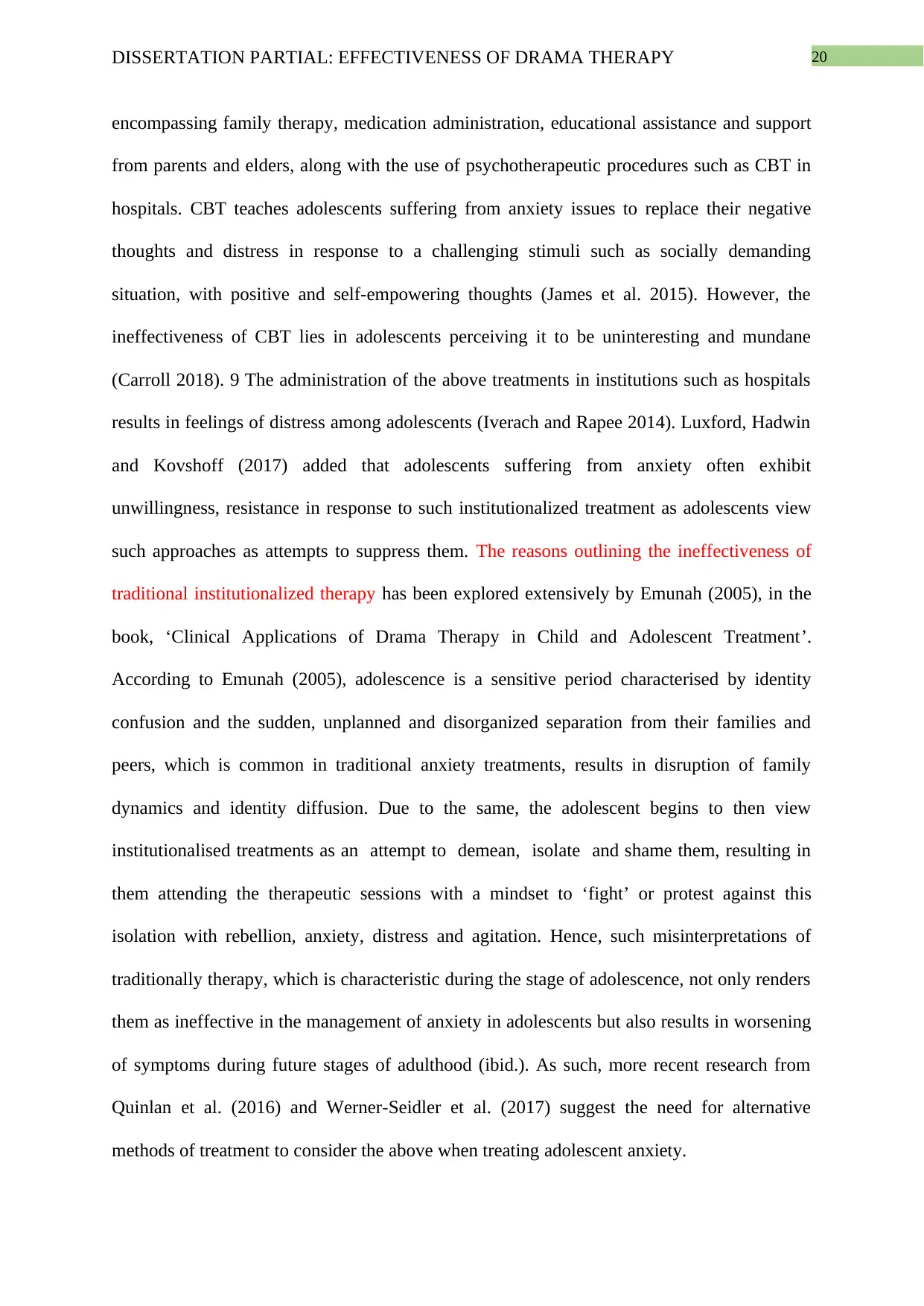
20DISSERTATION PARTIAL: EFFECTIVENESS OF DRAMA THERAPY
encompassing family therapy, medication administration, educational assistance and support
from parents and elders, along with the use of psychotherapeutic procedures such as CBT in
hospitals. CBT teaches adolescents suffering from anxiety issues to replace their negative
thoughts and distress in response to a challenging stimuli such as socially demanding
situation, with positive and self-empowering thoughts (James et al. 2015). However, the
ineffectiveness of CBT lies in adolescents perceiving it to be uninteresting and mundane
(Carroll 2018). 9 The administration of the above treatments in institutions such as hospitals
results in feelings of distress among adolescents (Iverach and Rapee 2014). Luxford, Hadwin
and Kovshoff (2017) added that adolescents suffering from anxiety often exhibit
unwillingness, resistance in response to such institutionalized treatment as adolescents view
such approaches as attempts to suppress them. The reasons outlining the ineffectiveness of
traditional institutionalized therapy has been explored extensively by Emunah (2005), in the
book, ‘Clinical Applications of Drama Therapy in Child and Adolescent Treatment’.
According to Emunah (2005), adolescence is a sensitive period characterised by identity
confusion and the sudden, unplanned and disorganized separation from their families and
peers, which is common in traditional anxiety treatments, results in disruption of family
dynamics and identity diffusion. Due to the same, the adolescent begins to then view
institutionalised treatments as an attempt to demean, isolate and shame them, resulting in
them attending the therapeutic sessions with a mindset to ‘fight’ or protest against this
isolation with rebellion, anxiety, distress and agitation. Hence, such misinterpretations of
traditionally therapy, which is characteristic during the stage of adolescence, not only renders
them as ineffective in the management of anxiety in adolescents but also results in worsening
of symptoms during future stages of adulthood (ibid.). As such, more recent research from
Quinlan et al. (2016) and Werner-Seidler et al. (2017) suggest the need for alternative
methods of treatment to consider the above when treating adolescent anxiety.
encompassing family therapy, medication administration, educational assistance and support
from parents and elders, along with the use of psychotherapeutic procedures such as CBT in
hospitals. CBT teaches adolescents suffering from anxiety issues to replace their negative
thoughts and distress in response to a challenging stimuli such as socially demanding
situation, with positive and self-empowering thoughts (James et al. 2015). However, the
ineffectiveness of CBT lies in adolescents perceiving it to be uninteresting and mundane
(Carroll 2018). 9 The administration of the above treatments in institutions such as hospitals
results in feelings of distress among adolescents (Iverach and Rapee 2014). Luxford, Hadwin
and Kovshoff (2017) added that adolescents suffering from anxiety often exhibit
unwillingness, resistance in response to such institutionalized treatment as adolescents view
such approaches as attempts to suppress them. The reasons outlining the ineffectiveness of
traditional institutionalized therapy has been explored extensively by Emunah (2005), in the
book, ‘Clinical Applications of Drama Therapy in Child and Adolescent Treatment’.
According to Emunah (2005), adolescence is a sensitive period characterised by identity
confusion and the sudden, unplanned and disorganized separation from their families and
peers, which is common in traditional anxiety treatments, results in disruption of family
dynamics and identity diffusion. Due to the same, the adolescent begins to then view
institutionalised treatments as an attempt to demean, isolate and shame them, resulting in
them attending the therapeutic sessions with a mindset to ‘fight’ or protest against this
isolation with rebellion, anxiety, distress and agitation. Hence, such misinterpretations of
traditionally therapy, which is characteristic during the stage of adolescence, not only renders
them as ineffective in the management of anxiety in adolescents but also results in worsening
of symptoms during future stages of adulthood (ibid.). As such, more recent research from
Quinlan et al. (2016) and Werner-Seidler et al. (2017) suggest the need for alternative
methods of treatment to consider the above when treating adolescent anxiety.
⊘ This is a preview!⊘
Do you want full access?
Subscribe today to unlock all pages.

Trusted by 1+ million students worldwide
1 out of 46
Related Documents
Your All-in-One AI-Powered Toolkit for Academic Success.
+13062052269
info@desklib.com
Available 24*7 on WhatsApp / Email
![[object Object]](/_next/static/media/star-bottom.7253800d.svg)
Unlock your academic potential
Copyright © 2020–2025 A2Z Services. All Rights Reserved. Developed and managed by ZUCOL.




